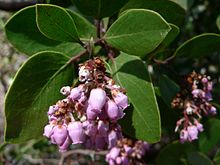Arctostaphylos
| Arctostaphylos | |
|---|---|
 |
|
| Whiteleaf Manzanita (Arctostaphylos viscida) | |
| Scientific classification | |
| Kingdom: | Plantae |
| (unranked): | Angiosperms |
| (unranked): | Eudicots |
| (unranked): | Asterids |
| Order: | Ericales |
| Family: | Ericaceae |
| Subfamily: | Arbutoideae |
| Genus: |
Arctostaphylos Adans. |
| Type species | |
|
Arctostaphylos uva-ursi (L.) Spreng. |
|
| Species | |
|
About 60, see text. |
|
About 60, see text.
Arctostaphylos (/ˌɑːrktoʊˈstæfᵻləs, -lɒs/;arkto bear + staphyle grape) is a genus of plants comprising the manzanitas (/ˌmænzəˈniːtəz/) and bearberries. They are shrubs or small trees.
There are about 60 species of Arctostaphylos, ranging from ground-hugging arctic, coastal, and mountain species to small trees up to 6 m tall. Most are evergreen (one species deciduous), with small oval leaves 1–7 cm long, arranged spirally on the stems. The flowers are bell-shaped, white or pale pink, and borne in small clusters of 2-20 together; flowering is in the spring. The fruit are small berries, ripening in the summer or autumn. The berries of some species are edible.
...
Wikipedia
